Seoul for beginners

This video follows travel writer Christopher Reynolds as he learns his way around the lively landscape of food in Seoul, South Korea’s capital. Night markets, sharp scissors, twitching octopus, mung bean cakes, and restaurant recommendations are al
Reporting from Seoul — The flight from LAX took about 13 hours. The alphabet had 24 letters, none familiar from my youth. Lunch squirmed on my plate. And an unpredictable enemy waited 35 miles to the north.
Yet Seoul soothed me.
In five January days as a rookie among Seoul’s palaces, parks and marketplaces, I gained 4 pounds despite walking countless miles down alleys full of people but empty of graffiti and litter.
For two of those days, I relied on translator/guides for help. Otherwise I trusted Seoul’s multilingualism, which includes subway signs and museum labels in Korean, English, Japanese and Chinese. That worked fine.
In fact, for anyone accustomed to Greater Los Angeles (population about 13 million), the hospitality, cosmopolitanism, technological acumen, influential popular culture and relentless tidiness of South Korea’s capital (population about 26 million) are likely to feel inviting, humbling and tranquilizing.
Here are a few things a first-timer learns in Seoul:
Start with a palace
One of the astonishing things about Seoul is that nearly all of it has been built in the last 65 years. South Korea since 1953 has gone from scorched earth to one of the world’s strongest economies, cranking out Samsung and LG phones and Hyundai and Kia cars, along with pop music and TV dramas that entertain millions of people beyond its boundaries.
But the city does have five restored palaces, all traceable to the Joseon Dynasty that ruled Korea from the 1390s to the 1890s.
A baseball trip through Japan is just what a jaded MLB fan needed »
In those five centuries, the Joseon kings, their civil servants and soldiers created a writing system, spread Confucian philosophy and built a culture that endured a seven-year Japanese invasion in the 1590s; a Japanese occupation from 1910 to 1945; and the Korean War of 1950-53, which killed at least 2.5 million people (by Encyclopedia Britannica’s estimate) and separated Russian-backed North Korea (officially the Democratic People’s Republic of Korea) from U.S.-backed South Korea (officially the Republic of Korea).
It makes sense to start with a tour of the reconstructed Gyeongbokgung Palace, where the first Joseon king presided. There are stately tiled roofs. Elaborately painted ceilings. Expansive grounds. And if you can be here at 10 a.m. or 2 p.m., you’ll see a ceremonial changing of the guard at the palace’s Gwanghwamun Gate.
Check the mustaches
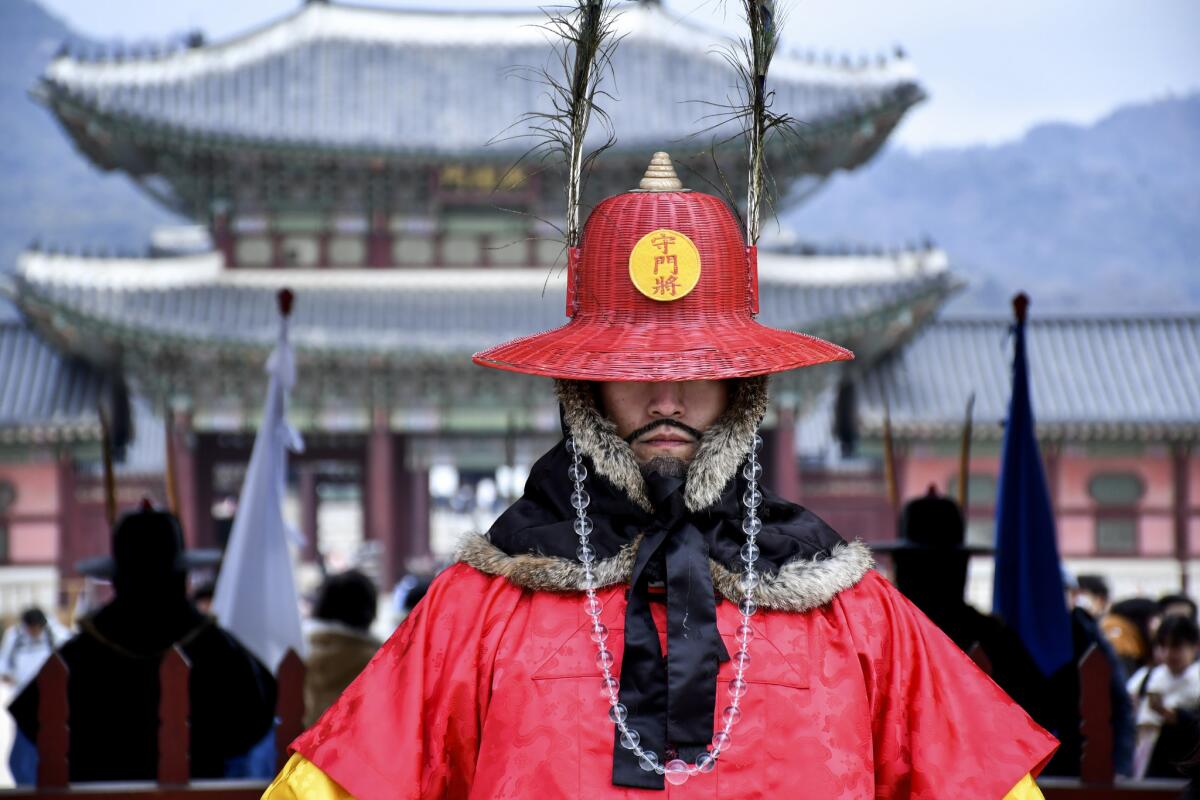
You’ll know the 20-minute ceremony is starting when you hear the slow beat of a booming bass drum and see sumunjang (guardsmen) in bright colors bearing flags through the Gyeongbokgung courtyard. Notice the scimitars, the spears and the fake mustaches — a clue that these are re-enactors, not soldiers.
The changing of the guard is a tourism-driven tradition because there is no Korean royal family left to protect. Enjoy it and grab a selfie or two with an unsmiling guardsman. But also remember that South Korea has a very real, very busy military at work along the Demilitarized Zone 35 miles north and beyond.
Phu Quoc is now a global destination. Is that a good thing? »
Maybe one more palace
If it’s Tuesday, Gyeongbokgung Palace is closed. In that case — or if you’re keenly interested in design —head for Changdeokgung Palace.
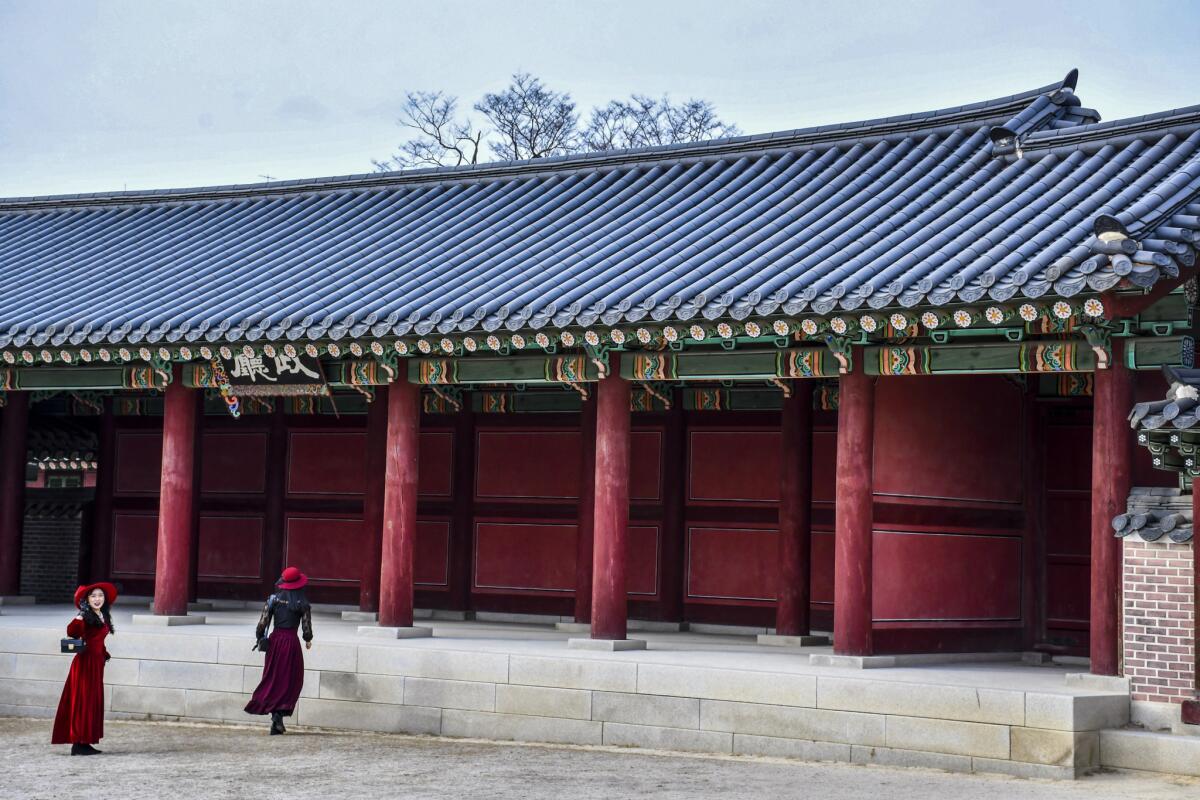
This palace (closed Mondays) is bigger than Gyeongbokgung, and many of its buildings date to the 17th century.
Its gardens, where the royal family spent idle hours among pavilions, ponds and foliage, have been singled out by UNESCO for their harmonious design and have their own tour.
But don’t imagine that this palace has always been placid and happy. If you sign on for a tour of the palace or gardens, ask the guide how Jeongjo of Joseon came to the throne in the 1770s and brace yourself for a tale of palace intrigue and filicide as horrifying as any gothic drama.
Sample the action in Myeong-dong
This is one of the city’s foremost shopping districts, packed with hotels, restaurants, food stalls and visitor favorites such as the Nanta Theater, which offers a wordless, kid-friendly musical comedy about a kitchen crew preparing a wedding feast.
A network of narrow alleys between the skyscrapers compresses people, bright lights and food smells in a dramatic way. In the restaurants, you’ll find kimchi (salted and fermented vegetables), gochujang (fermented bean paste), bulgogi (marinated beef and pork) and bibimbap (rice dishes). Out among the stalls, you’ll glimpse corn, sausage, seafood, fruit, churros, lobster, chocolate and more, sometimes in startling combinations.
Why Asia? Why now? Here’s why, from a writer who now calls it home »
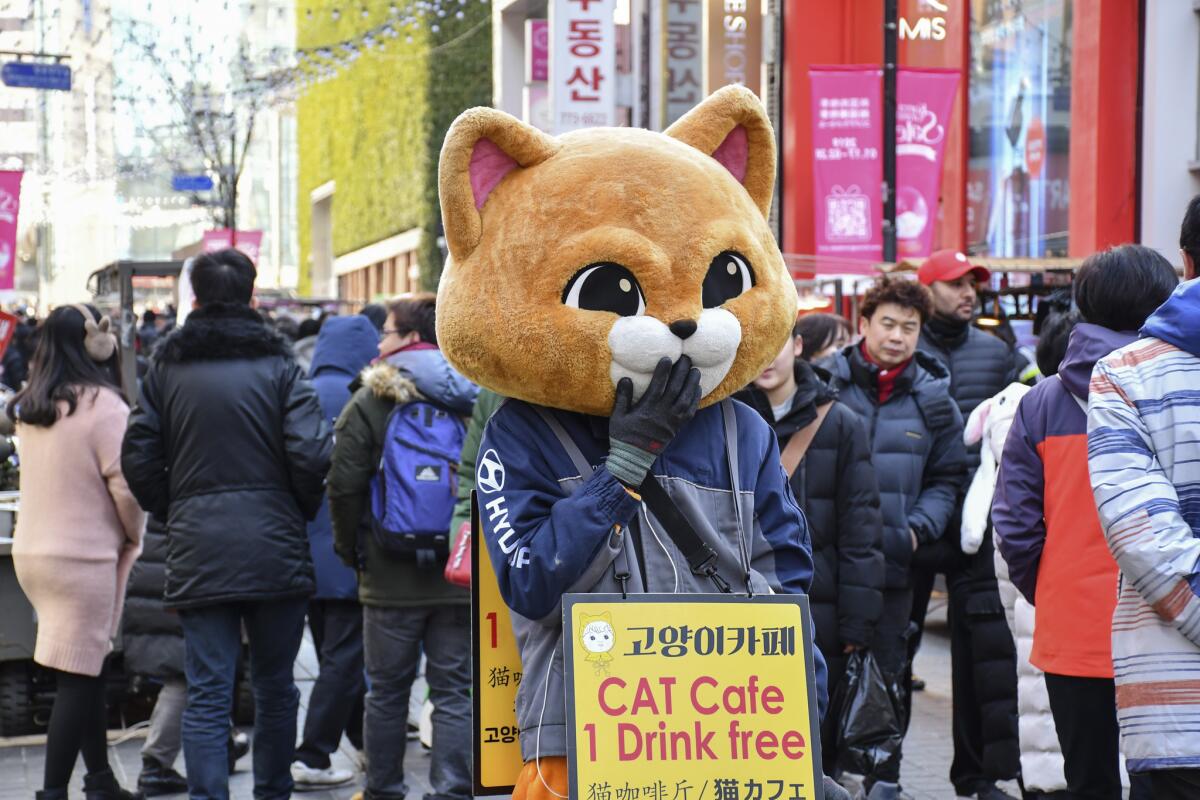
The people-watching is top notch too. (That man in the cat costume? He’s advertising one of the two cat cafes in the neighborhood.)
Or you could just shop. Myeong-dong includes Shinsegae and Lotte, two of the country’s biggest luxury department stores.
Chow down at Gwangjang Market, then stroll along the stream
Myeong-dong and other Seoul districts have plenty of intriguing alleys. But Gwangjang is renowned for having the most food stalls, about 200, many offering mung bean pancakes, the market’s signature dish. Two people can dine on a sampler plate stacked with bean, fish and beef cakes for about $10. Take a seat, watch the world squeeze by and, if you can find a common language, shoot the breeze with your cook.
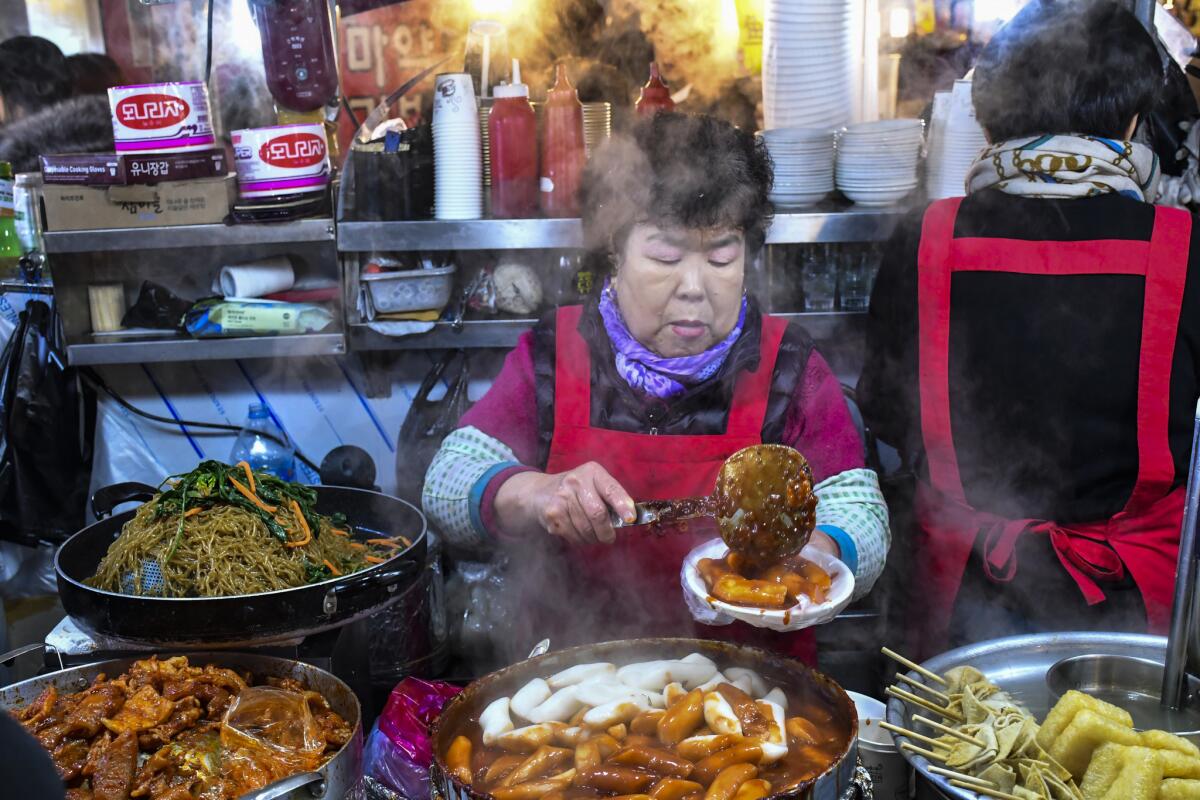
For a change of pace, take a stroll along the market-adjacent Cheonggyecheon Stream, a park (with walkways and burbling waters) that offers a measure of calm in the middle of the city, covering several miles and passing beneath about two dozen bridges.
Check out an old folk village
Glimpses of Seoul as it stood before 1953 are rare, so it’s a good idea to visit Bukchon Hanok Folk Village, a neighborhood of homes from centuries past, ingeniously restored and still occupied. Residents post signs in four languages to discourage tourists from trespassing and urge them to whisper. Which, remarkably, they do. The main street leads to a hilltop with splendid views of the old tile roofs in the foreground, the modern skyline beyond.
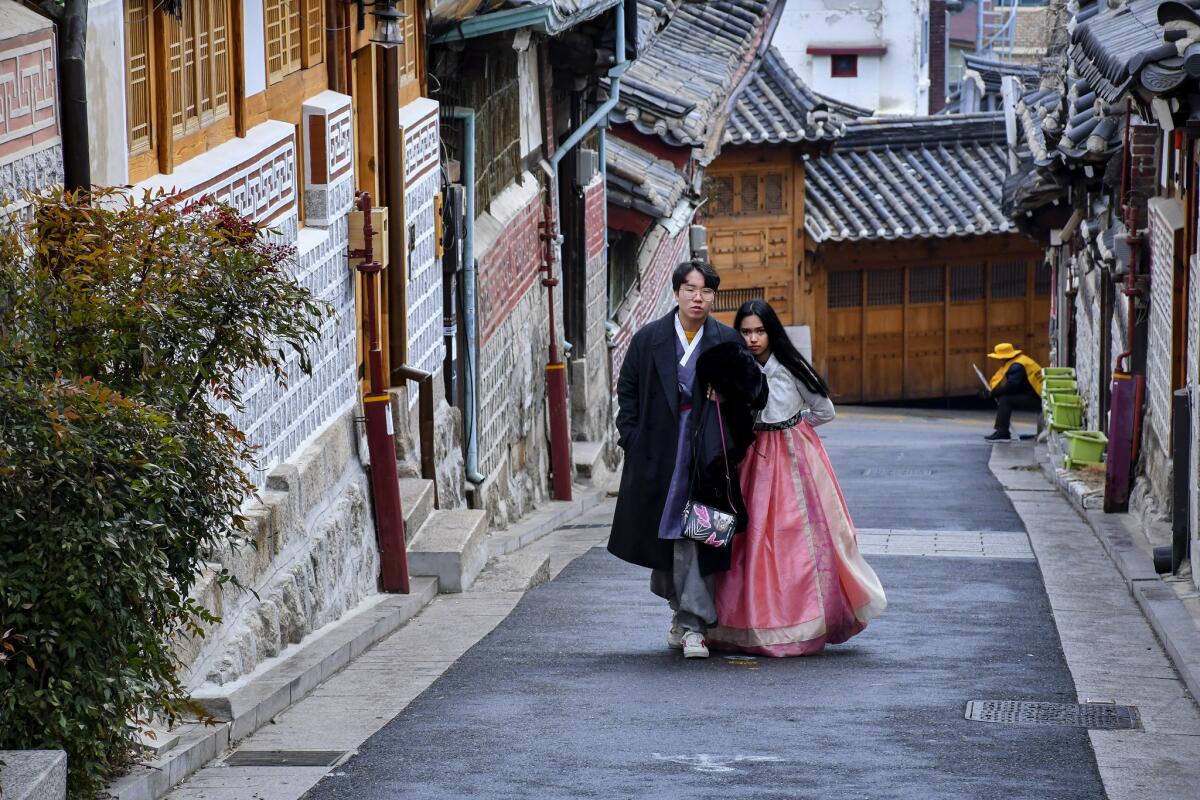
You might want to rent clothes
When you approach a palace or historic neighborhood, you can count on seeing fellow tourists in hanbok — historical costumes designed to mimic fashions of the Joseon Dynasty. These are especially popular among selfie-snapping young women and families from Asia, but all nationalities are welcome at the hanbok shops that rent costumes by the hour or day; $15-$20 for four hours is typical.
At this Beijing hotel, guests learn the art of shadow puppetry »
As an American who doesn’t have Korean roots or take a lot of selfies, I wasn’t ready to suit up. But you (or your teenage daughter) might like to. If so, you get free admission to the palaces.
Ascend Namsan
Namsan Seoul Tower, completed in 1969, rises 777 feet above 800-foot-high Namsan Mountain. The result is an unbounded view of skyscrapers (nearly all built since 1969), the surrounding hills and valleys of the city, the Han River and the wealthy, modern commercial district of Gangnam (which means “south of the river” in Korean).
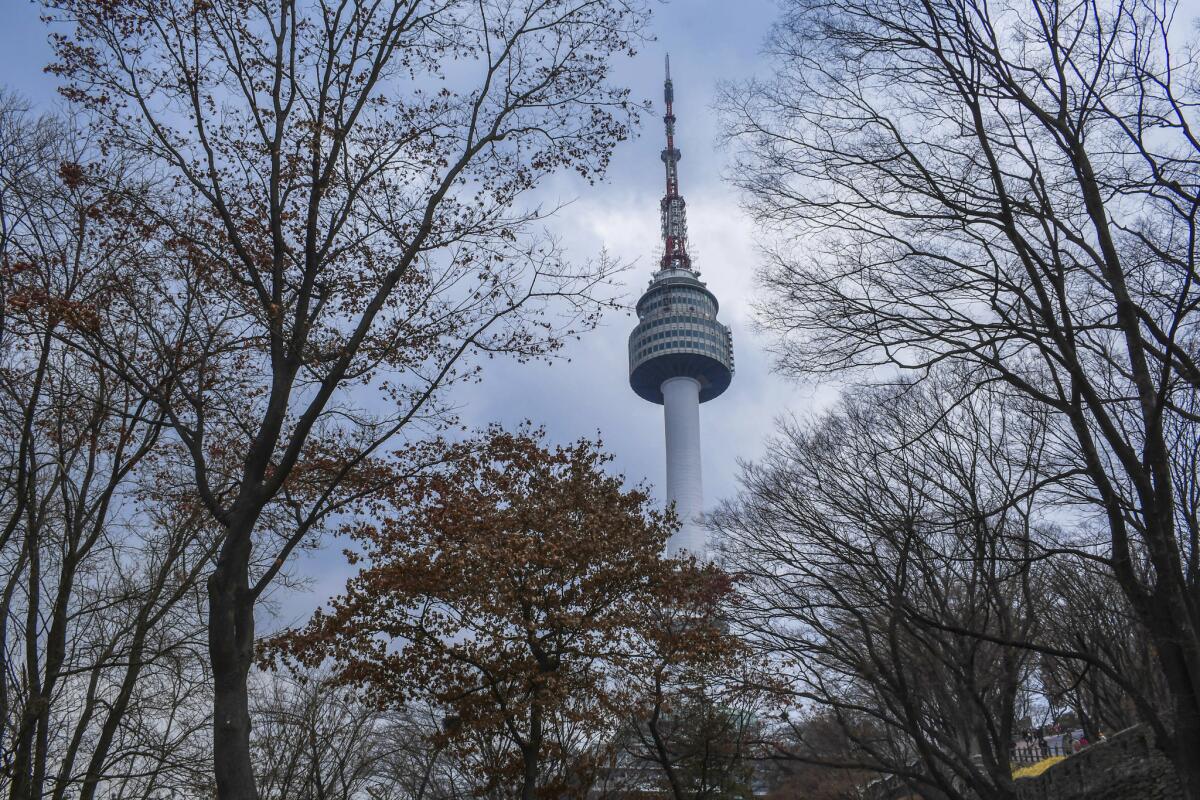
The Namsan Cable Car can take you to the top of Namsan Mountain for about $9 round trip. There’s plenty to see and snack on, but for the biggest views, pay $10 more for the elevator ride to the tower’s wraparound observation deck.
Draw your line between trendy and touristy
Many sources warned me about the touristy and expat-centric nature of the Itaewon area, so I left it off my itinerary. Despite similar warnings, I kept on the Insa-dong area because its legions of souvenir shops are neighbored by many art galleries and the Buddhist Jogyesa Temple.
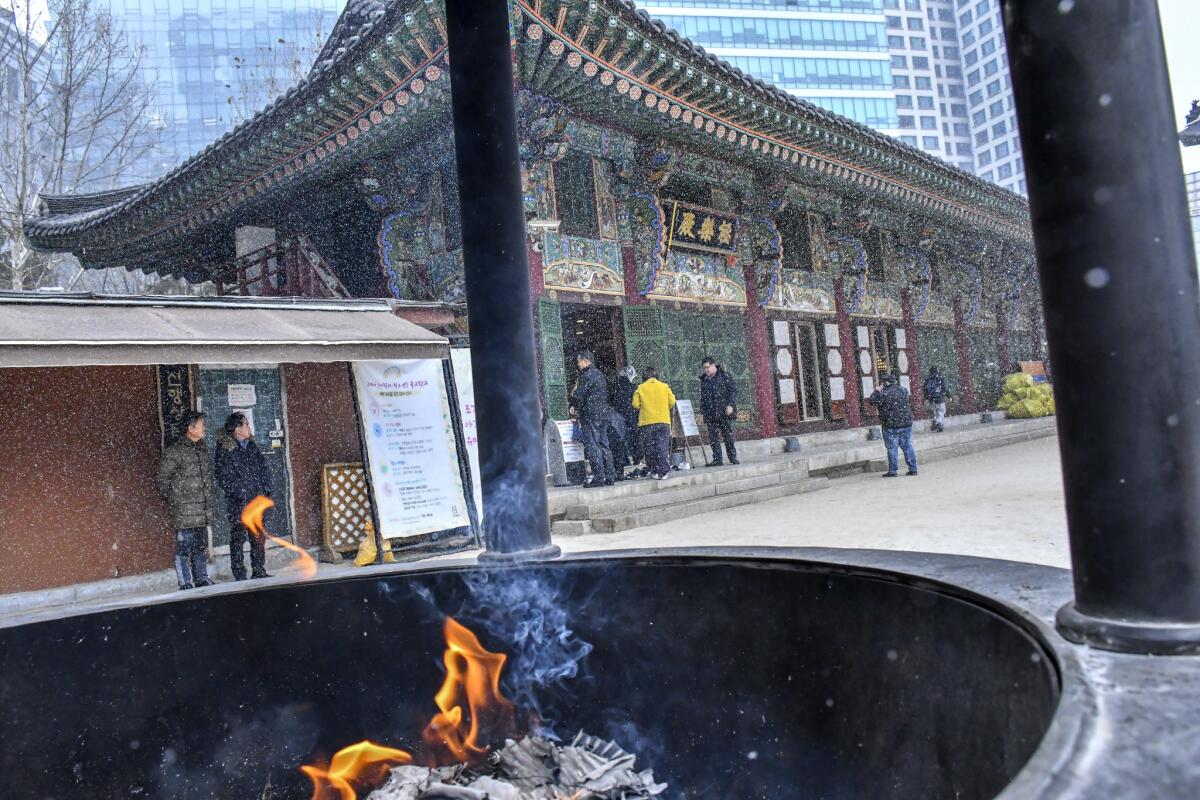
If your kitsch threshold is low, you might want to advance straight to Samcheong-dong. I landed in this trendy neighborhood because I wanted to try the widely praised barbecue at the Maple Tree House restaurant. But as my guide circled the neighborhood in search of a parking space (a common and difficult activity in Seoul), I found myself wishing I had another hour to knock around Samcheong-dong’s dozens of shops, galleries and cafes, as many young, trendy Seoul locals were doing.
Buy seafood downstairs, eat it upstairs
The Noryangjin Fisheries Wholesale Market, easily reached by subway, is mostly within in a slick building that opened in 2016. You step inside, confront a dizzying array of sea creatures, challenge yourself to eat adventurously, then make purchases. If you like, vendors will immediately send those purchases upstairs to be cooked per your request.
It isn’t cheap, but you will remember the day. My guide and I spent about $130 browsing and consuming a massive late lunch of crab (steamed), abalone (roasted) and octopus tentacles (raw), still coiling and uncoiling though no longer attached to their original owner.
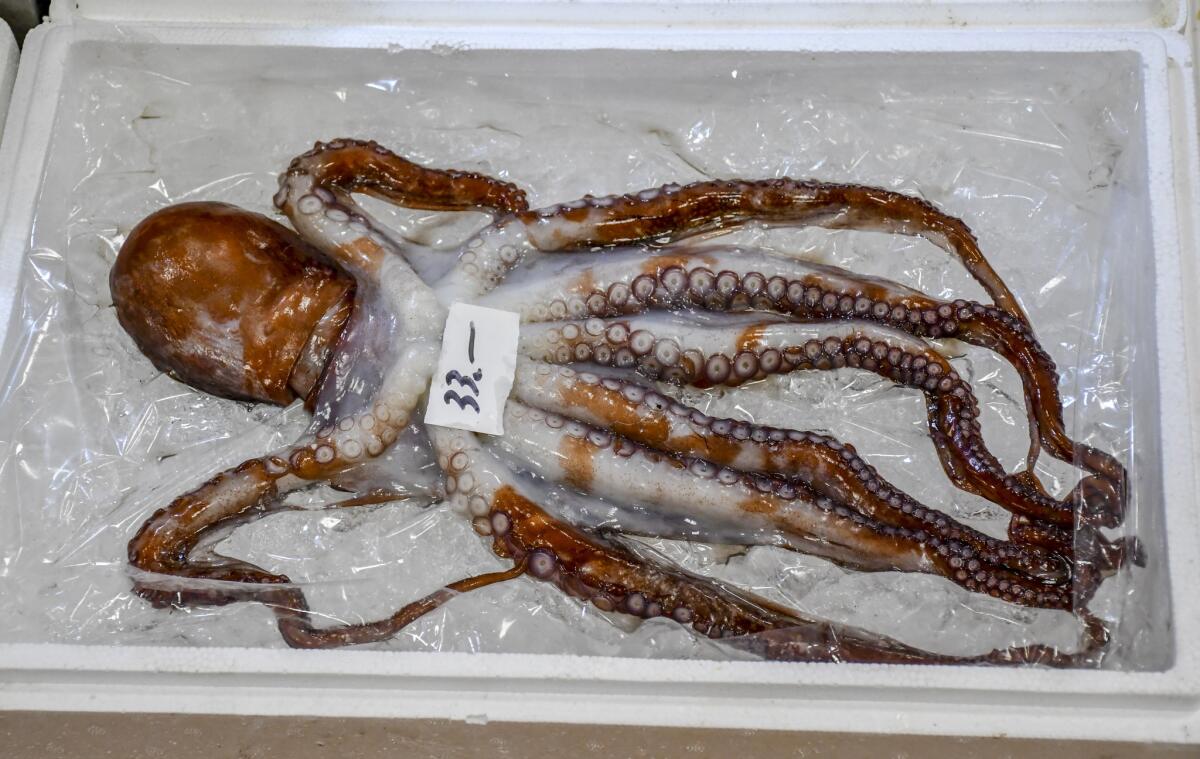
Some people claim to love them, and I felt obliged to try them. I didn’t get the appeal beyond the novelty of eating something that’s still moving. They’re very chewy and not nearly as satisfying as abalone and crab. (For the record: They’re not alive despite the twitching. The posthumous coiling has to do with how their nervous systems are wired.)
If you’re a photographer, you’ll also want to step into the old fish market building, which dates to 1971 and, during my visit, still had more than a dozen merchants. It’s a smellier, moodier, darker, more cinematic place, well-suited to a Jason Bourne chase scene.
Inspect the wall, climb Naksan
For a good walk, start at the Seoul City Wall Museum in the Dongdaemun District. From there, follow the path along the wall, which dates to 1396. The route will take you through blue-collar neighborhoods of old low-rise houses, with increasingly grand views. You’ll eventually reach Naksan Park, at the top of Naksan mountain, where several footpaths converge and there are courts for badminton and foot volleyball.
You’ll also see the boldly colored walls of the Ihwa-dong Mural Village, which includes the Noh Bak Gallery, Lock Museum and an immaculately decorated cafe that specializes in coffee, sausages and beer.
Step into the belly of the DDP
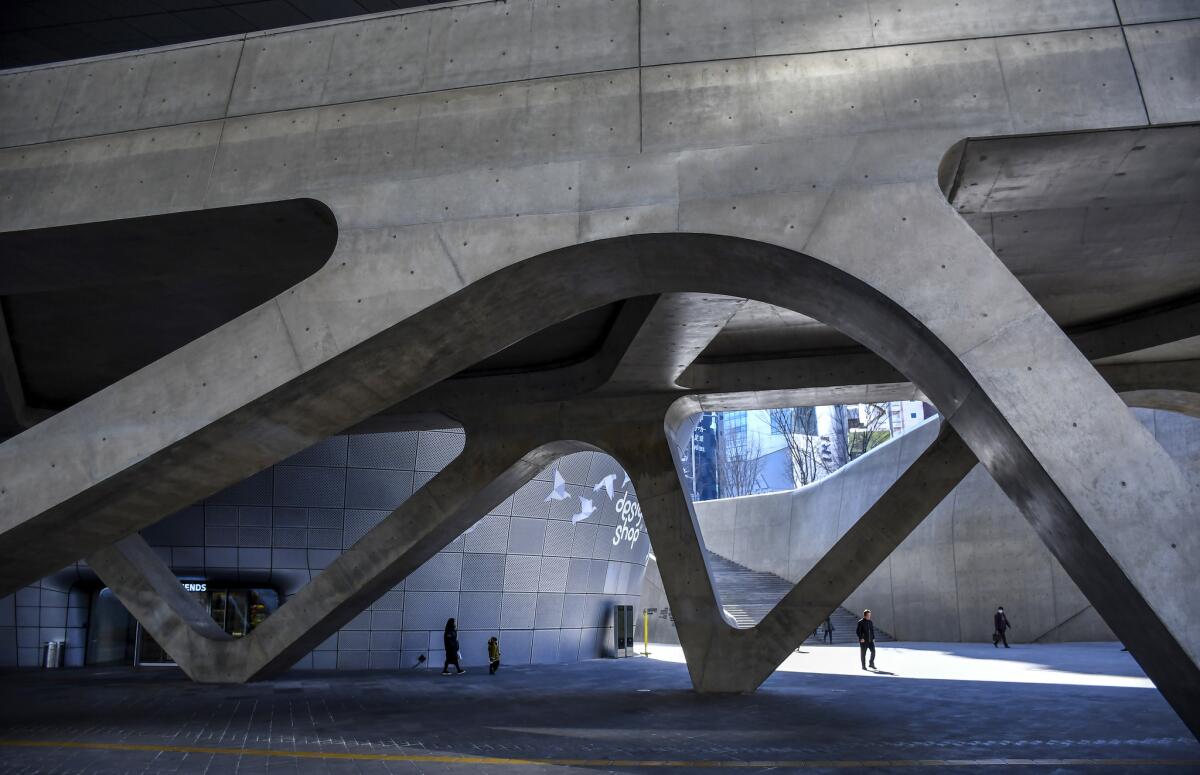
Dongdaemun Design Plaza, a sinuous metal-and-concrete beast of a building by architect Zaha Hadid, takes up a big chunk of the low ground in the Dongdaemun District. Hadid’s blank walls were a bit much for me — why not let artists use a few square feet of those big, empty spaces? — but it’s visually fascinating. On one side is a design museum and on the other a collection of design-oriented shops.
Savor these public spaces, but beware the spotlight
I wanted to take in a few more architectural landmarks so I strolled past Seoul’s gleaming blue-glass City Hall (completed in 2013), which rises above the old stone Art Deco City Hall (completed in 1926 and now a library).
These two cool buildings are neighbored by a public plaza where political demonstrators often gather. The only off-note of my stop occurred as I walked past an anti-North Korea demonstration, when one young man faced me and said, “Yankee, go home.”
I ignored him and caught a subway to the Old Seoul Station, site of another 1920s building neighbored by a modern addition. Here, too, demonstrators crowded the area — but this group was older and, as the images on their signs showed, seemingly happier with U.S. policy.
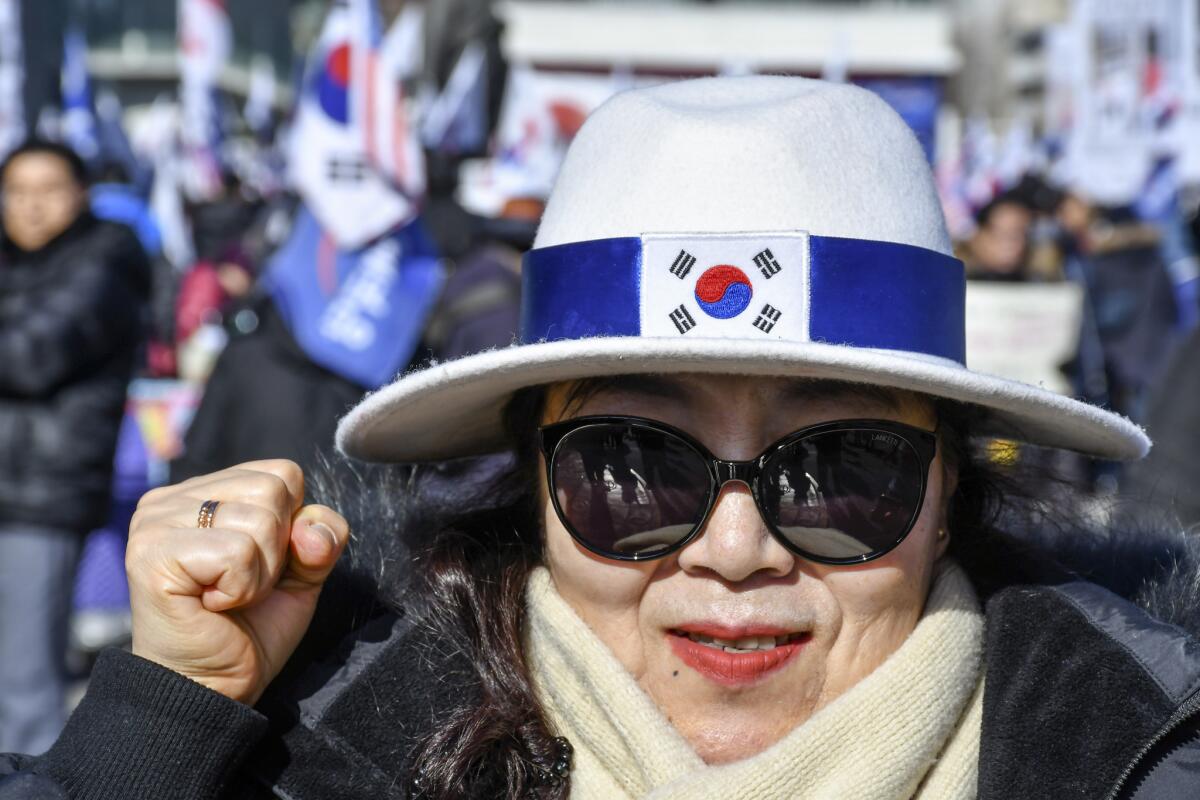
In fact, spotting a likely American at the edge of the crowd, one demonstrator rushed up to give me chocolates. Then others offered me a Korean flag pin. A calendar. An offer to buy me coffee. Two more took selfies with me, all within 15 minutes.
This was far better than being told to go home, but I nevertheless stepped away as soon as I could. Public protests are treacherous enough when you know the language. When you don’t — eating octopus is safer, even if it squirms.
To see the DMZ
The Demilitarized Zone, which separates North and South Korea about 35 miles north of Seoul, has become one of the world’s most austere tourist attractions.
It can be visited only on a guided tour, booked in advance. Closures on short notice are common, and one of the zone’s most popular elements, the Joint Security Area (Panmunjom) where northern and southern troops faced off for more than 60 years, was closed in October.
Xian, China, beyond its ancient terra-cotta warriors »
Officials from the two countries said it would reopen once weaponry and guard posts were removed from the area, but three tour operators said the JSA remains closed and no reopening date has been announced.
Meanwhile, tour operators continue to pitch other DMZ itineraries, including Imjingak Park/Resort, Dora Observatory, a DMZ Museum, the Dorasan train station and the Third Tunnel, discovered under the South Korean side in 1978. Tour prices range from $40 (for a half day) to $140 (for a daylong visit). You’ll need to book at least a few days in advance and bring your passport.
Among the tour operators that serve the DMZ:
International Cultural Service Club
If you go
THE BEST WAY TO SEOUL
From LAX, Korean and Asiana offer nonstop service to Seoul, and JAL, Delta, United, Air China, All Nippon, Air Canada and EVA offer connecting service (change of planes). Restricted round-trip airfare from $961, including taxes and fees.
WHERE TO STAY
Hotel 28, 13 Myeong-dong 7-gil, Jung-gu, Seoul. This sleek spot in Myeong-dong, opened in 2016, has Korean film as its theme. Doubles about $200 a night. Inside is a Din Tai Fung restaurant.
TMark Grand Hotel Myeong-dong, 52 Toegye-roe, Jung-gu, Seoul. Popular with international tour groups, well suited for families. Doubles from $114.
Lotte City Hotel Myeong-dong, 362 Samil-daero, Jung-gu, Seoul. Business district near Myeong-dong.Two restaurants, one European-style. Lower rates on weekends. Doubles from $150.
The Plaza, 119 Sogong-ro, Jung-gu, Seoul. Ideal for well-fixed first-timers in Seoul. Staffers speak lots of English. Five restaurants and bars. Part of Marriott’s Autograph collection. Doubles from $185.
WHERE TO EAT
Myeong-dong Kyoja, 29 Myeong-dong 10-gil, Jung-gu, Seoul. Noodle house famous for kalguksu, a vegetable broth with noodles, dumplings and meat. Very busy, well-suited to a quick bite. Most noodle dishes $7-$10. There’s a second branch at 8 Myeong-dong 10-gil and another in Itaewon.
Very Street Kitchen, 205 Mallijae-ro, Jungnim-dong, Jung-gu, Seoul. Korean fusion cooking for a hip crowd in an old stone building. Good for a romantic dinner. Dinner only. English spoken.
Noryangjin Fisheries Wholesale Market, 674, Nodeul-ro, Dongjak-gu, Seoul . Expensive but memorable.
Food court, Shinsegae Department Store, 63 Sogong-ro, Jung-gu, Seoul. Five upscale restaurants fill the fifth floor of the store’s main building, with another on the sixth, and about a dozen more casual eateries in the basement of the store’s newer building. I liked Maruteo, which specializes in Korean bulgogi— grilled, marinated beef. Main dishes $12-$18.
TO LEARN MORE
South Korea’s biggest tour operator, Hanatour ([800] 455-8965), offers a variety of day trips with English-speaking guides in Seoul and the DMZ, as well as multiday itineraries covering multiple cities.

L.A. Times Today airs Monday through Friday at 7 p.m. and 10 p.m. on Spectrum News 1.
Follow Reynolds on Twitter: @MrCSReynolds
More to Read
Sign up for The Wild
We’ll help you find the best places to hike, bike and run, as well as the perfect silent spots for meditation and yoga.
You may occasionally receive promotional content from the Los Angeles Times.







